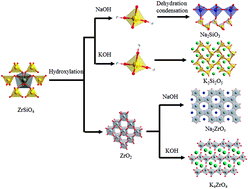In situ spectroscopic studies of decomposition of ZrSiO4 during alkali fusion process using various hydroxides†
Abstract
ZrSiO4 powder synthesized by the sol–gel method is used to study the reaction mechanism of natural zircon mineral treated by an alkali fusion method. The reaction processes are analyzed by in situ Raman spectroscopy. Other characterization experiments using techniques, such as FTIR spectroscopy, TG-DTA and X-ray powder diffraction complement and verify the Raman spectroscopy study. The results reveal that hydroxylation–dehydration play important roles during the alkali-fusion process. Hydroxylation action breaks some bonds between Si and O in silicon–oxygen tetrahedral and releases zircon as ZrO2 and silanol groups and then dehydration makes SiO4 tetrahedron polymerize to the silicate with different lattice structure. The electron-donating ability of the O atom in molten alkali determines the number of Si–O bonds broken in SiO4 tetrahedral and the lattice structure of silicate products. Finally, with further development of the reaction, the bridge-oxygen bonds of intermediate products are substitutes for non-bridging-oxygen bonds.


 Please wait while we load your content...
Please wait while we load your content...